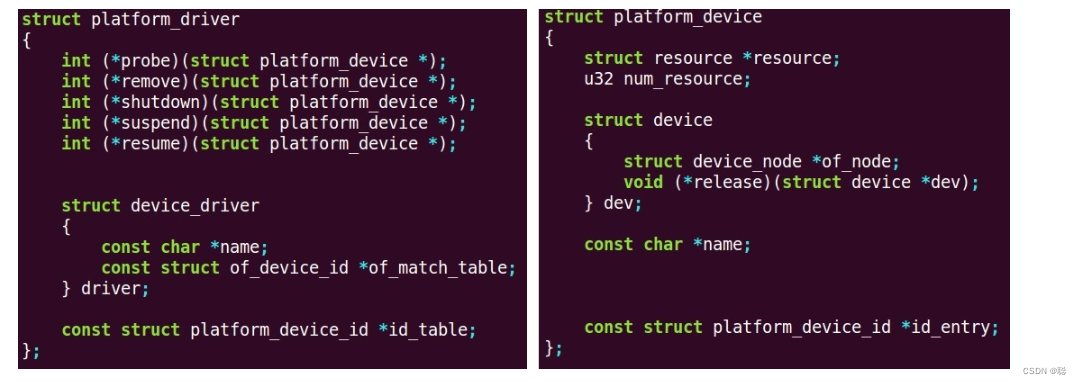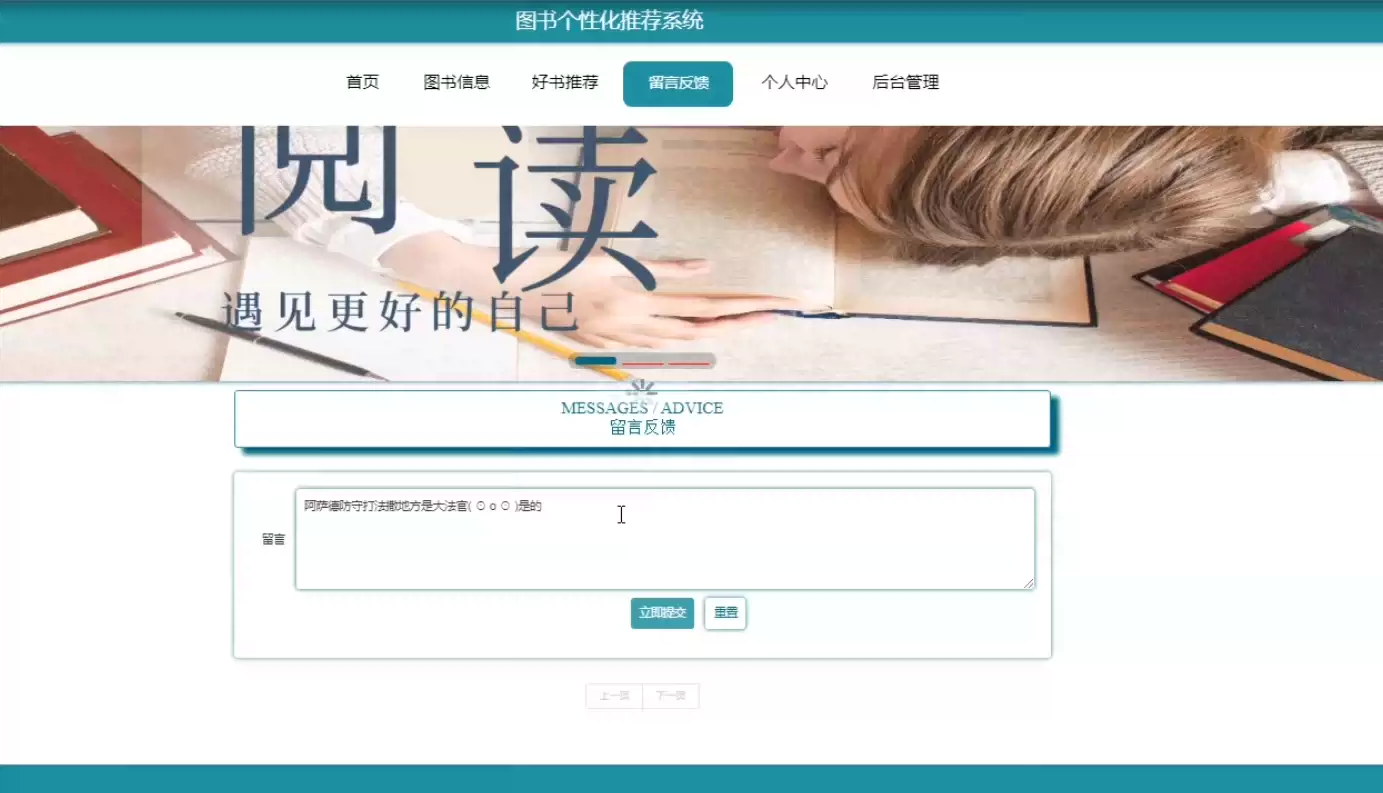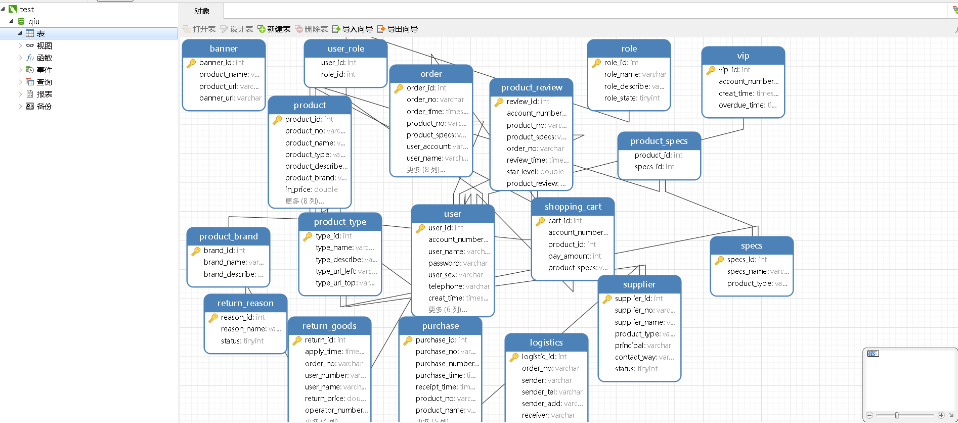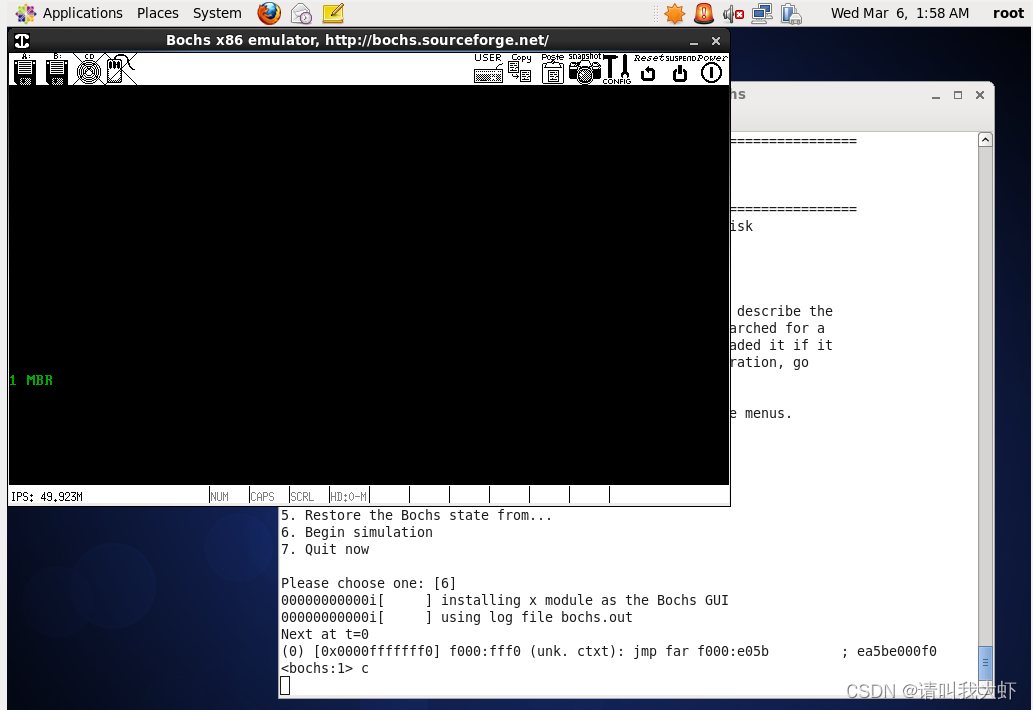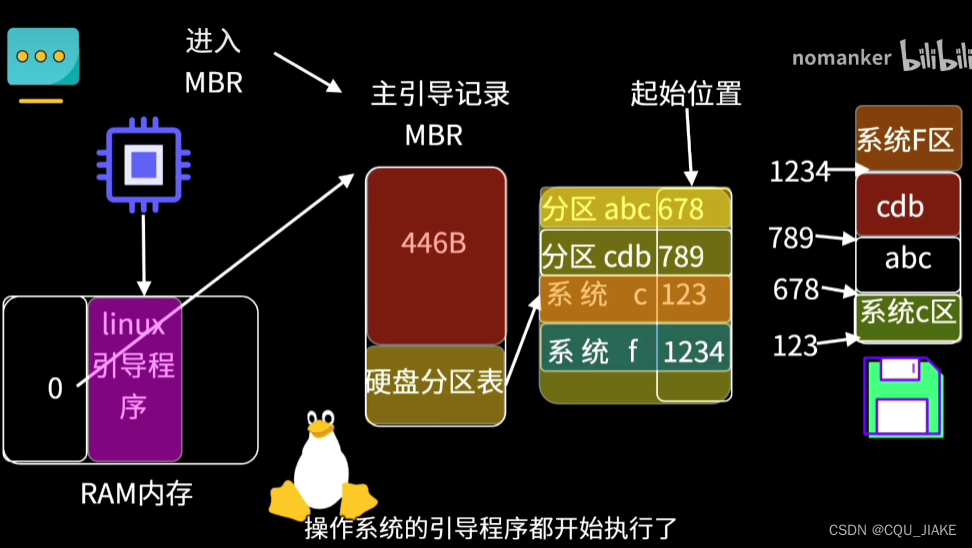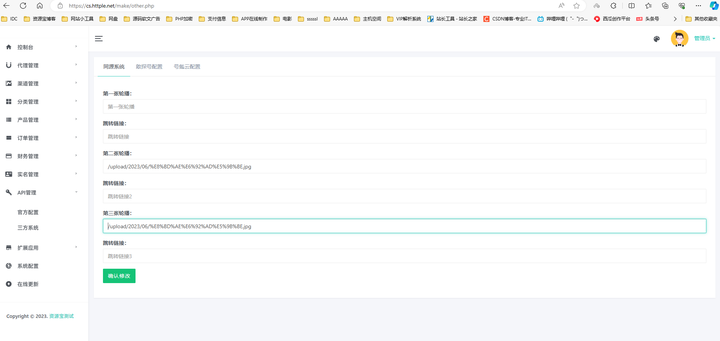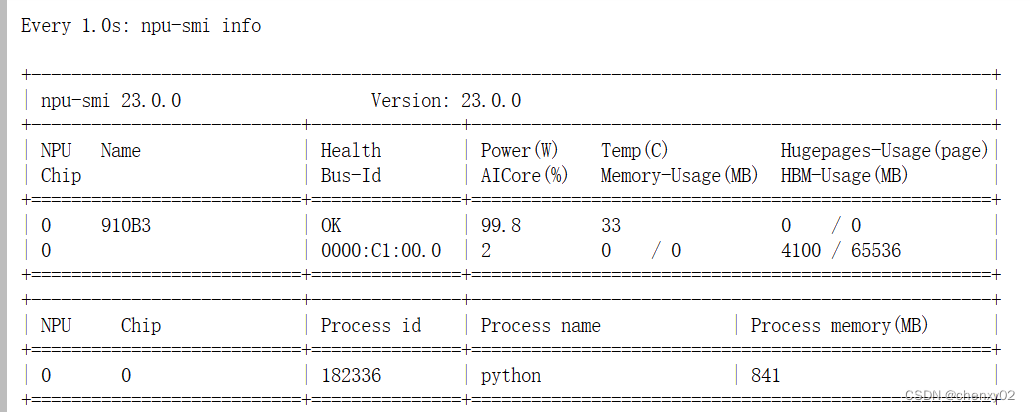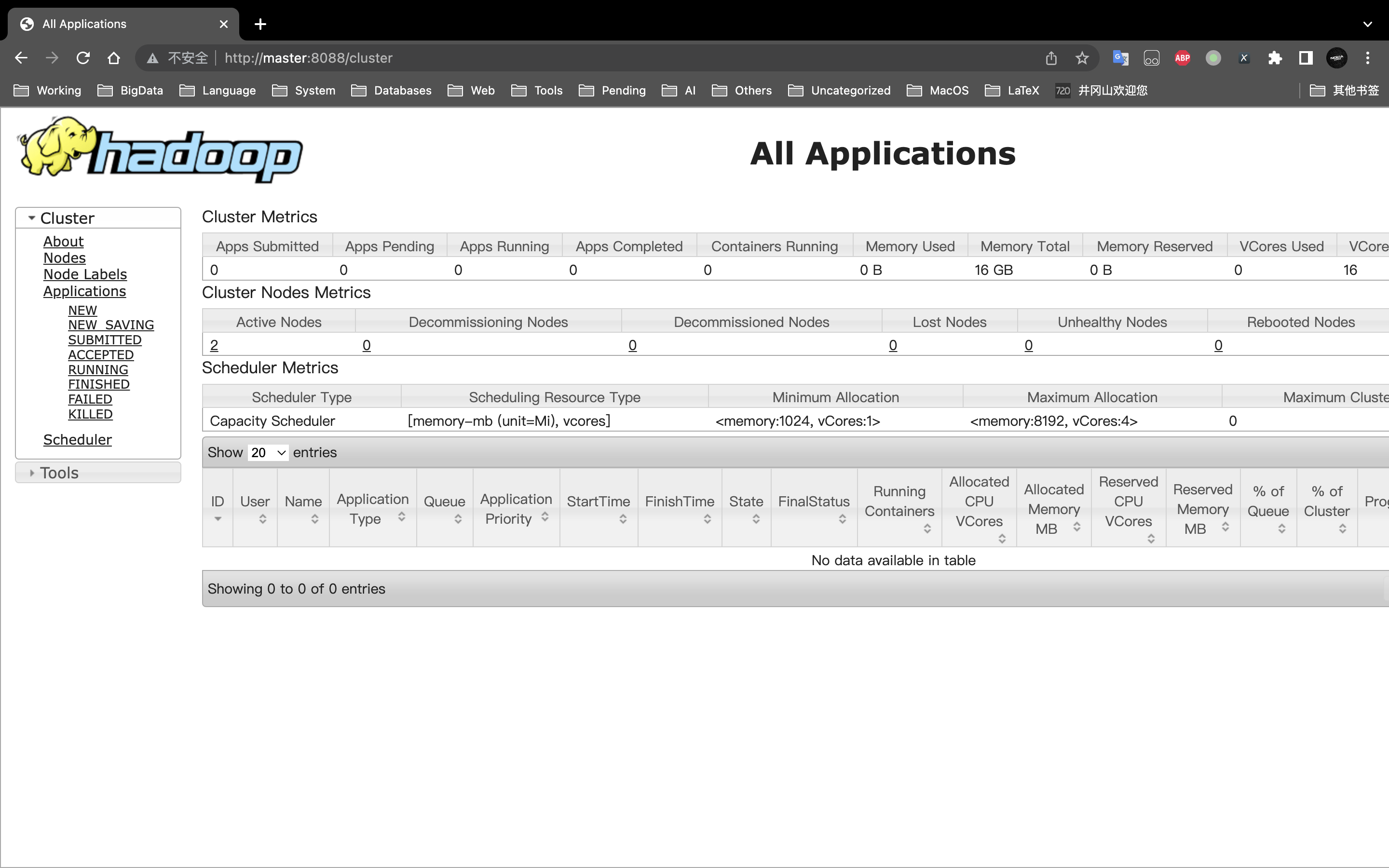
专栏介绍:YOLOv9改进系列 | 包含深度学习最新创新,主力高效涨点!!!
一、改进点介绍
Dynamic Snake Convolution是一种针对细长微弱的局部结构特征与复杂多变的全局形态特征设计的卷积模块。
RepNCSPELAN4是YOLOv9中的特征提取模块,类似YOLOv5和v8中的C2f与C3模块。
二、RepNCSPELAN4Dynamic模块详解
2.1 模块简介
RepNCSPELAN4Dynamic的主要思想: 使用Dynamic Snake Convolution与RepNCSPELAN4中融合。
三、 RepNCSPELAN4Dynamic模块使用教程
3.1 RepNCSPELAN4Dynamic模块的代码
class RepNBottleneck_DySnakeConv(RepNBottleneck):
# Standard bottleneck
def __init__(self, c1, c2, shortcut=True, g=1, k=(3, 3), e=0.5): # ch_in, ch_out, shortcut, kernels, groups, expand
super().__init__(c1, c2, shortcut, g, k, e)
c_ = int(c2 * e) # hidden channels
self.cv1 = RepConvN(c1, c_, k[0], 1)
self.cv2 = Conv(c_, c2, k[1], s=1, g=g)
self.add = shortcut and c1 == c2
class RepNCSP_DySnakeConv(RepNCSP):
# CSP Bottleneck with 3 convolutions
def __init__(self, c1, c2, n=1, shortcut=True, g=1, e=0.5): # ch_in, ch_out, number, shortcut, groups, expansion
super().__init__(c1, c2, n, shortcut, g, e)
c_ = int(c2 * e) # hidden channels
self.cv1 = DySnakeConv(c1, c_)
self.cv2 = DySnakeConv(c1, c_)
self.cv3 = DySnakeConv(2 * c_, c2) # optional act=FReLU(c2)
self.m = nn.Sequential(*(RepNBottleneck_DySnakeConv(c_, c_, shortcut, g, e=1.0) for _ in range(n)))
class RepNCSPELAN4DySnakeConv(RepNCSPELAN4):
# csp-elan
def __init__(self, c1, c2, c3, c4, c5=1): # ch_in, ch_out, number, shortcut, groups, expansion
super().__init__(c1, c2, c3, c4, c5)
self.cv1 = Conv(c1, c3, k=1, s=1)
self.cv2 = nn.Sequential(RepNCSP_DySnakeConv(c3 // 2, c4, c5), DySnakeConv(c4, c4, 3))
self.cv3 = nn.Sequential(RepNCSP_DySnakeConv(c4, c4, c5), DySnakeConv(c4, c4, 3))
self.cv4 = Conv(c3 + (2 * c4), c2, 1, 1)
class DySnakeConv(nn.Module):
def __init__(self, inc, ouc, k=3) -> None:
super().__init__()
self.conv_0 = Conv(inc, ouc, k)
self.conv_x = DSConv(inc, ouc, 0, k)
self.conv_y = DSConv(inc, ouc, 1, k)
def forward(self, x):
return torch.cat([self.conv_0(x), self.conv_x(x), self.conv_y(x)], dim=1)
class DSConv(nn.Module):
def __init__(self, in_ch, out_ch, morph, kernel_size=3, if_offset=True, extend_scope=1):
"""
The Dynamic Snake Convolution
:param in_ch: input channel
:param out_ch: output channel
:param kernel_size: the size of kernel
:param extend_scope: the range to expand (default 1 for this method)
:param morph: the morphology of the convolution kernel is mainly divided into two types
along the x-axis (0) and the y-axis (1) (see the paper for details)
:param if_offset: whether deformation is required, if it is False, it is the standard convolution kernel
"""
super(DSConv, self).__init__()
# use the <offset_conv> to learn the deformable offset
self.offset_conv = nn.Conv2d(in_ch, 2 * kernel_size, 3, padding=1)
self.bn = nn.BatchNorm2d(2 * kernel_size)
self.kernel_size = kernel_size
# two types of the DSConv (along x-axis and y-axis)
self.dsc_conv_x = nn.Conv2d(
in_ch,
out_ch,
kernel_size=(kernel_size, 1),
stride=(kernel_size, 1),
padding=0,
)
self.dsc_conv_y = nn.Conv2d(
in_ch,
out_ch,
kernel_size=(1, kernel_size),
stride=(1, kernel_size),
padding=0,
)
self.gn = nn.GroupNorm(out_ch // 4, out_ch)
self.act = Conv.default_act
self.extend_scope = extend_scope
self.morph = morph
self.if_offset = if_offset
def forward(self, f):
offset = self.offset_conv(f)
offset = self.bn(offset)
# We need a range of deformation between -1 and 1 to mimic the snake's swing
offset = torch.tanh(offset)
input_shape = f.shape
dsc = DSC(input_shape, self.kernel_size, self.extend_scope, self.morph)
deformed_feature = dsc.deform_conv(f, offset, self.if_offset)
if self.morph == 0:
x = self.dsc_conv_x(deformed_feature.type(f.dtype))
x = self.gn(x)
x = self.act(x)
return x
else:
x = self.dsc_conv_y(deformed_feature.type(f.dtype))
x = self.gn(x)
x = self.act(x)
return x
# Core code, for ease of understanding, we mark the dimensions of input and output next to the code
class DSC(object):
def __init__(self, input_shape, kernel_size, extend_scope, morph):
self.num_points = kernel_size
self.width = input_shape[2]
self.height = input_shape[3]
self.morph = morph
self.extend_scope = extend_scope # offset (-1 ~ 1) * extend_scope
# define feature map shape
"""
B: Batch size C: Channel W: Width H: Height
"""
self.num_batch = input_shape[0]
self.num_channels = input_shape[1]
"""
input: offset [B,2*K,W,H] K: Kernel size (2*K: 2D image, deformation contains <x_offset> and <y_offset>)
output_x: [B,1,W,K*H] coordinate map
output_y: [B,1,K*W,H] coordinate map
"""
def _coordinate_map_3D(self, offset, if_offset):
device = offset.device
# offset
y_offset, x_offset = torch.split(offset, self.num_points, dim=1)
y_center = torch.arange(0, self.width).repeat([self.height])
y_center = y_center.reshape(self.height, self.width)
y_center = y_center.permute(1, 0)
y_center = y_center.reshape([-1, self.width, self.height])
y_center = y_center.repeat([self.num_points, 1, 1]).float()
y_center = y_center.unsqueeze(0)
x_center = torch.arange(0, self.height).repeat([self.width])
x_center = x_center.reshape(self.width, self.height)
x_center = x_center.permute(0, 1)
x_center = x_center.reshape([-1, self.width, self.height])
x_center = x_center.repeat([self.num_points, 1, 1]).float()
x_center = x_center.unsqueeze(0)
if self.morph == 0:
"""
Initialize the kernel and flatten the kernel
y: only need 0
x: -num_points//2 ~ num_points//2 (Determined by the kernel size)
!!! The related PPT will be submitted later, and the PPT will contain the whole changes of each step
"""
y = torch.linspace(0, 0, 1)
x = torch.linspace(
-int(self.num_points // 2),
int(self.num_points // 2),
int(self.num_points),
)
y, x = torch.meshgrid(y, x)
y_spread = y.reshape(-1, 1)
x_spread = x.reshape(-1, 1)
y_grid = y_spread.repeat([1, self.width * self.height])
y_grid = y_grid.reshape([self.num_points, self.width, self.height])
y_grid = y_grid.unsqueeze(0) # [B*K*K, W,H]
x_grid = x_spread.repeat([1, self.width * self.height])
x_grid = x_grid.reshape([self.num_points, self.width, self.height])
x_grid = x_grid.unsqueeze(0) # [B*K*K, W,H]
y_new = y_center + y_grid
x_new = x_center + x_grid
y_new = y_new.repeat(self.num_batch, 1, 1, 1).to(device)
x_new = x_new.repeat(self.num_batch, 1, 1, 1).to(device)
y_offset_new = y_offset.detach().clone()
if if_offset:
y_offset = y_offset.permute(1, 0, 2, 3)
y_offset_new = y_offset_new.permute(1, 0, 2, 3)
center = int(self.num_points // 2)
# The center position remains unchanged and the rest of the positions begin to swing
# This part is quite simple. The main idea is that "offset is an iterative process"
y_offset_new[center] = 0
for index in range(1, center):
y_offset_new[center + index] = (y_offset_new[center + index - 1] + y_offset[center + index])
y_offset_new[center - index] = (y_offset_new[center - index + 1] + y_offset[center - index])
y_offset_new = y_offset_new.permute(1, 0, 2, 3).to(device)
y_new = y_new.add(y_offset_new.mul(self.extend_scope))
y_new = y_new.reshape(
[self.num_batch, self.num_points, 1, self.width, self.height])
y_new = y_new.permute(0, 3, 1, 4, 2)
y_new = y_new.reshape([
self.num_batch, self.num_points * self.width, 1 * self.height
])
x_new = x_new.reshape(
[self.num_batch, self.num_points, 1, self.width, self.height])
x_new = x_new.permute(0, 3, 1, 4, 2)
x_new = x_new.reshape([
self.num_batch, self.num_points * self.width, 1 * self.height
])
return y_new, x_new
else:
"""
Initialize the kernel and flatten the kernel
y: -num_points//2 ~ num_points//2 (Determined by the kernel size)
x: only need 0
"""
y = torch.linspace(
-int(self.num_points // 2),
int(self.num_points // 2),
int(self.num_points),
)
x = torch.linspace(0, 0, 1)
y, x = torch.meshgrid(y, x)
y_spread = y.reshape(-1, 1)
x_spread = x.reshape(-1, 1)
y_grid = y_spread.repeat([1, self.width * self.height])
y_grid = y_grid.reshape([self.num_points, self.width, self.height])
y_grid = y_grid.unsqueeze(0)
x_grid = x_spread.repeat([1, self.width * self.height])
x_grid = x_grid.reshape([self.num_points, self.width, self.height])
x_grid = x_grid.unsqueeze(0)
y_new = y_center + y_grid
x_new = x_center + x_grid
y_new = y_new.repeat(self.num_batch, 1, 1, 1)
x_new = x_new.repeat(self.num_batch, 1, 1, 1)
y_new = y_new.to(device)
x_new = x_new.to(device)
x_offset_new = x_offset.detach().clone()
if if_offset:
x_offset = x_offset.permute(1, 0, 2, 3)
x_offset_new = x_offset_new.permute(1, 0, 2, 3)
center = int(self.num_points // 2)
x_offset_new[center] = 0
for index in range(1, center):
x_offset_new[center + index] = (x_offset_new[center + index - 1] + x_offset[center + index])
x_offset_new[center - index] = (x_offset_new[center - index + 1] + x_offset[center - index])
x_offset_new = x_offset_new.permute(1, 0, 2, 3).to(device)
x_new = x_new.add(x_offset_new.mul(self.extend_scope))
y_new = y_new.reshape(
[self.num_batch, 1, self.num_points, self.width, self.height])
y_new = y_new.permute(0, 3, 1, 4, 2)
y_new = y_new.reshape([
self.num_batch, 1 * self.width, self.num_points * self.height
])
x_new = x_new.reshape(
[self.num_batch, 1, self.num_points, self.width, self.height])
x_new = x_new.permute(0, 3, 1, 4, 2)
x_new = x_new.reshape([
self.num_batch, 1 * self.width, self.num_points * self.height
])
return y_new, x_new
"""
input: input feature map [N,C,D,W,H];coordinate map [N,K*D,K*W,K*H]
output: [N,1,K*D,K*W,K*H] deformed feature map
"""
def _bilinear_interpolate_3D(self, input_feature, y, x):
device = input_feature.device
y = y.reshape([-1]).float()
x = x.reshape([-1]).float()
zero = torch.zeros([]).int()
max_y = self.width - 1
max_x = self.height - 1
# find 8 grid locations
y0 = torch.floor(y).int()
y1 = y0 + 1
x0 = torch.floor(x).int()
x1 = x0 + 1
# clip out coordinates exceeding feature map volume
y0 = torch.clamp(y0, zero, max_y)
y1 = torch.clamp(y1, zero, max_y)
x0 = torch.clamp(x0, zero, max_x)
x1 = torch.clamp(x1, zero, max_x)
input_feature_flat = input_feature.flatten()
input_feature_flat = input_feature_flat.reshape(
self.num_batch, self.num_channels, self.width, self.height)
input_feature_flat = input_feature_flat.permute(0, 2, 3, 1)
input_feature_flat = input_feature_flat.reshape(-1, self.num_channels)
dimension = self.height * self.width
base = torch.arange(self.num_batch) * dimension
base = base.reshape([-1, 1]).float()
repeat = torch.ones([self.num_points * self.width * self.height
]).unsqueeze(0)
repeat = repeat.float()
base = torch.matmul(base, repeat)
base = base.reshape([-1])
base = base.to(device)
base_y0 = base + y0 * self.height
base_y1 = base + y1 * self.height
# top rectangle of the neighbourhood volume
index_a0 = base_y0 - base + x0
index_c0 = base_y0 - base + x1
# bottom rectangle of the neighbourhood volume
index_a1 = base_y1 - base + x0
index_c1 = base_y1 - base + x1
# get 8 grid values
value_a0 = input_feature_flat[index_a0.type(torch.int64)].to(device)
value_c0 = input_feature_flat[index_c0.type(torch.int64)].to(device)
value_a1 = input_feature_flat[index_a1.type(torch.int64)].to(device)
value_c1 = input_feature_flat[index_c1.type(torch.int64)].to(device)
# find 8 grid locations
y0 = torch.floor(y).int()
y1 = y0 + 1
x0 = torch.floor(x).int()
x1 = x0 + 1
# clip out coordinates exceeding feature map volume
y0 = torch.clamp(y0, zero, max_y + 1)
y1 = torch.clamp(y1, zero, max_y + 1)
x0 = torch.clamp(x0, zero, max_x + 1)
x1 = torch.clamp(x1, zero, max_x + 1)
x0_float = x0.float()
x1_float = x1.float()
y0_float = y0.float()
y1_float = y1.float()
vol_a0 = ((y1_float - y) * (x1_float - x)).unsqueeze(-1).to(device)
vol_c0 = ((y1_float - y) * (x - x0_float)).unsqueeze(-1).to(device)
vol_a1 = ((y - y0_float) * (x1_float - x)).unsqueeze(-1).to(device)
vol_c1 = ((y - y0_float) * (x - x0_float)).unsqueeze(-1).to(device)
outputs = (value_a0 * vol_a0 + value_c0 * vol_c0 + value_a1 * vol_a1 +
value_c1 * vol_c1)
if self.morph == 0:
outputs = outputs.reshape([
self.num_batch,
self.num_points * self.width,
1 * self.height,
self.num_channels,
])
outputs = outputs.permute(0, 3, 1, 2)
else:
outputs = outputs.reshape([
self.num_batch,
1 * self.width,
self.num_points * self.height,
self.num_channels,
])
outputs = outputs.permute(0, 3, 1, 2)
return outputs
def deform_conv(self, input, offset, if_offset):
y, x = self._coordinate_map_3D(offset, if_offset)
deformed_feature = self._bilinear_interpolate_3D(input, y, x)
return deformed_feature
3.2 在YOlO v9中的添加教程
阅读YOLOv9添加模块教程或使用下文操作
1. 将YOLOv9工程中models下common.py文件中的最下行(否则可能因类继承报错)增加模块的代码。
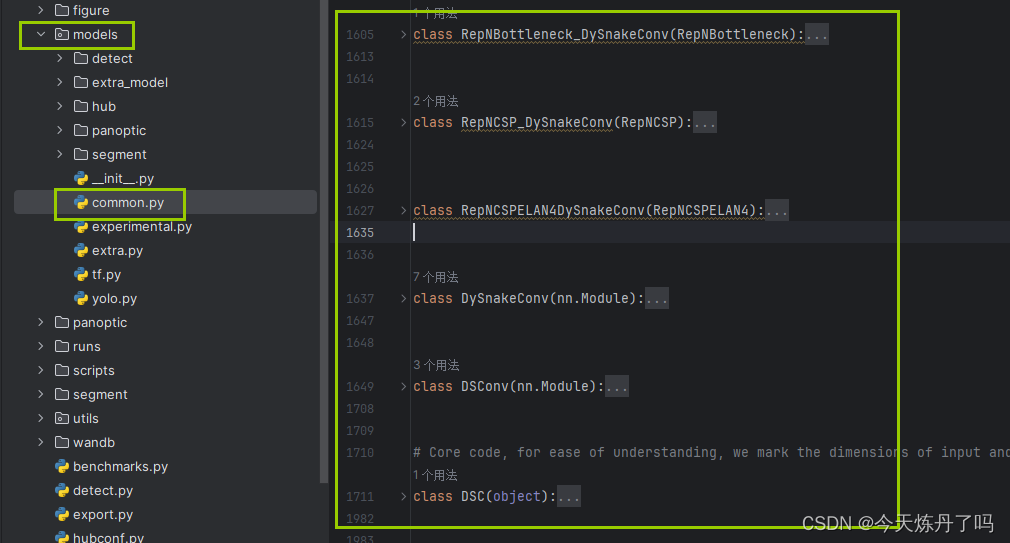
2. 将YOLOv9工程中models下yolo.py文件中的第681行(可能因版本变化而变化)增加以下代码。

RepNCSPELAN4, SPPELAN, RepNCSPELAN4DySnakeConv}:3.3 运行配置文件
# YOLOv9
# Powered bu https://blog.csdn.net/StopAndGoyyy
# parameters
nc: 80 # number of classes
#depth_multiple: 0.33 # model depth multiple
depth_multiple: 1 # model depth multiple
#width_multiple: 0.25 # layer channel multiple
width_multiple: 1 # layer channel multiple
#activation: nn.LeakyReLU(0.1)
#activation: nn.ReLU()
# anchors
anchors: 3
# YOLOv9 backbone
backbone:
[
[-1, 1, Silence, []],
# conv down
[-1, 1, Conv, [64, 3, 2]], # 1-P1/2
# conv down
[-1, 1, Conv, [128, 3, 2]], # 2-P2/4
# elan-1 block
[-1, 1, RepNCSPELAN4DySnakeConv, [256, 128, 64, 1]], # 3
# avg-conv down
[-1, 1, ADown, [256]], # 4-P3/8
# elan-2 block
[-1, 1, RepNCSPELAN4, [512, 256, 128, 1]], # 5
# avg-conv down
[-1, 1, ADown, [512]], # 6-P4/16
# elan-2 block
[-1, 1, RepNCSPELAN4, [512, 512, 256, 1]], # 7
# avg-conv down
[-1, 1, ADown, [512]], # 8-P5/32
# elan-2 block
[-1, 1, RepNCSPELAN4, [512, 512, 256, 1]], # 9
]
# YOLOv9 head
head:
[
# elan-spp block
[-1, 1, SPPELAN, [512, 256]], # 10
# up-concat merge
[-1, 1, nn.Upsample, [None, 2, 'nearest']],
[[-1, 7], 1, Concat, [1]], # cat backbone P4
# elan-2 block
[-1, 1, RepNCSPELAN4, [512, 512, 256, 1]], # 13
# up-concat merge
[-1, 1, nn.Upsample, [None, 2, 'nearest']],
[[-1, 5], 1, Concat, [1]], # cat backbone P3
# elan-2 block
[-1, 1, RepNCSPELAN4, [256, 256, 128, 1]], # 16 (P3/8-small)
# avg-conv-down merge
[-1, 1, ADown, [256]],
[[-1, 13], 1, Concat, [1]], # cat head P4
# elan-2 block
[-1, 1, RepNCSPELAN4, [512, 512, 256, 1]], # 19 (P4/16-medium)
# avg-conv-down merge
[-1, 1, ADown, [512]],
[[-1, 10], 1, Concat, [1]], # cat head P5
# elan-2 block
[-1, 1, RepNCSPELAN4, [512, 512, 256, 1]], # 22 (P5/32-large)
# multi-level reversible auxiliary branch
# routing
[5, 1, CBLinear, [[256]]], # 23
[7, 1, CBLinear, [[256, 512]]], # 24
[9, 1, CBLinear, [[256, 512, 512]]], # 25
# conv down
[0, 1, Conv, [64, 3, 2]], # 26-P1/2
# conv down
[-1, 1, Conv, [128, 3, 2]], # 27-P2/4
# elan-1 block
[-1, 1, RepNCSPELAN4, [256, 128, 64, 1]], # 28
# avg-conv down fuse
[-1, 1, ADown, [256]], # 29-P3/8
[[23, 24, 25, -1], 1, CBFuse, [[0, 0, 0]]], # 30
# elan-2 block
[-1, 1, RepNCSPELAN4, [512, 256, 128, 1]], # 31
# avg-conv down fuse
[-1, 1, ADown, [512]], # 32-P4/16
[[24, 25, -1], 1, CBFuse, [[1, 1]]], # 33
# elan-2 block
[-1, 1, RepNCSPELAN4, [512, 512, 256, 1]], # 34
# avg-conv down fuse
[-1, 1, ADown, [512]], # 35-P5/32
[[25, -1], 1, CBFuse, [[2]]], # 36
# elan-2 block
[-1, 1, RepNCSPELAN4, [512, 512, 256, 1]], # 37
# detection head
# detect
[[31, 34, 37, 16, 19, 22], 1, DualDDetect, [nc]], # DualDDetect(A3, A4, A5, P3, P4, P5)
]
3.4 训练过程

欢迎关注!
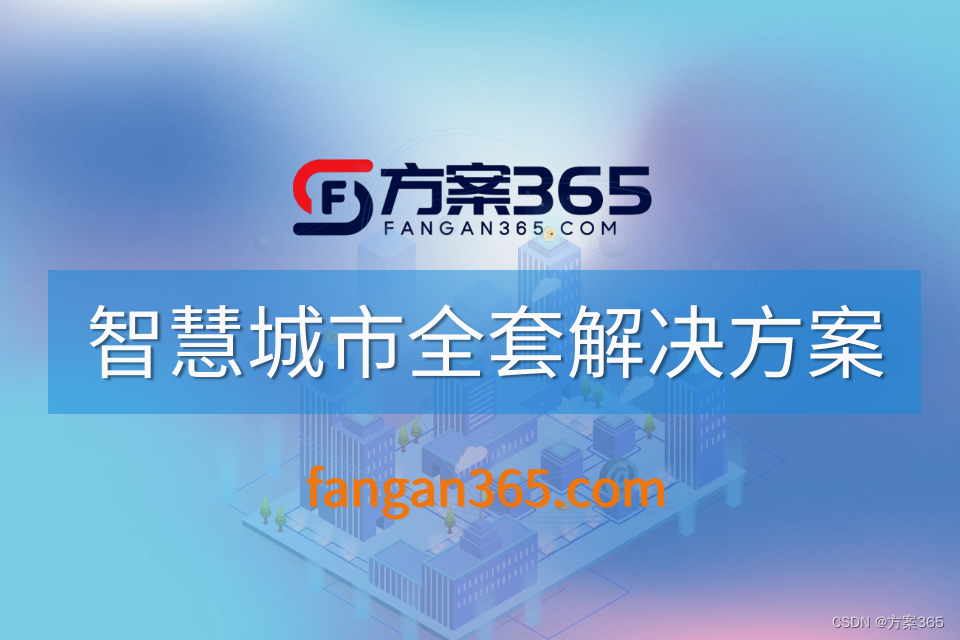



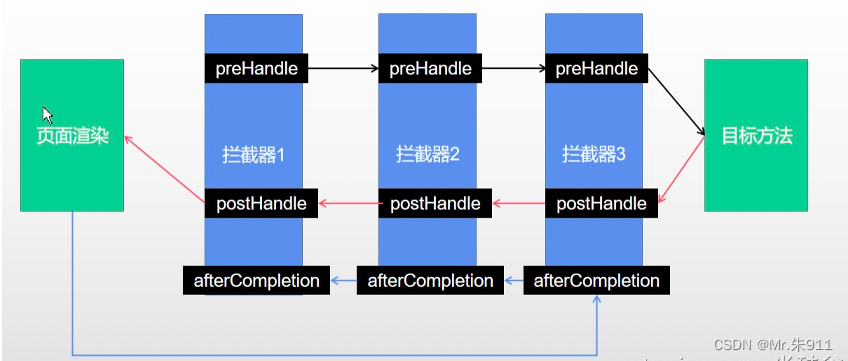

![在排序数组中查找元素的第一个和最后一个位置[中等]](https://img-blog.csdnimg.cn/direct/7e69b4198aa64474896bf8bc8ec5b97e.png)



